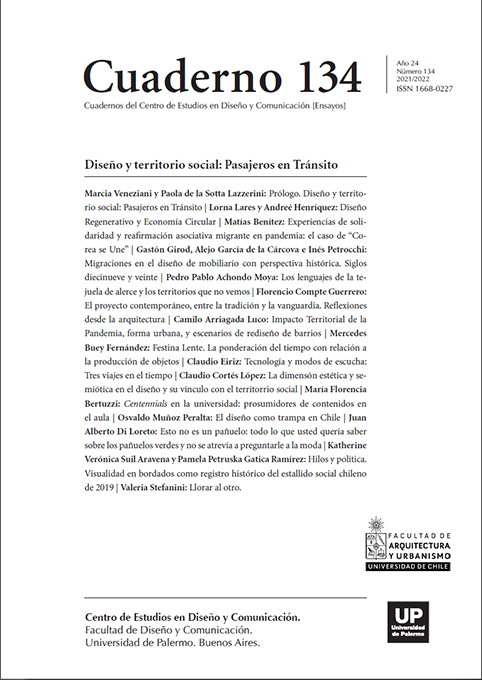Los lenguajes de la tejuela de alerce y los territorios que no vemos
Abstract
The article proposes, through a phenomenological reading of the larch shingle, new possibilities of understanding between human life and the other-than-human and their relations. The socio-environmental and epistemic crisis in which we are immersed, invite us to another thought about life. This reflection requires to reinterpret, with an intellectual courage, the materialities and the connections that build life on planet. The larch shingle, narrated in its multiple interactions and interpreted from its own languages (material, temporal and territorial) leads us -–amazingly– to a breadth of the thinking, feeling and knowing the entanglements between life and territory.
References
Aliste, E. y Núñez, A. (2020). Geografías del devenir. Narración y hermenéutica geográfica. Santiago: LOM.
Bachelard, G. (2000). La poética del espacio. Buenos Aires: FCE Argentina.
Barad, K. (2003). “Posthumanist performativity: toward an understanding of how matter comes to matter”. Signs 28: 801-31.
Bennett, J. (2010). Vibrant Matter: A Political Ecology of Things. Durham: Duke University Press.
Bennett, L. (2016). “Thinking like a Brick: Posthumanism and Building Materials” En: Taylor, C.A. et al. (eds.). Posthuman Research Practices in Education. UK: Palgrave Macmillan.
Boninsegna, J. A. y R. Holmes. (1985). “Fitzroya cupressoides yields a 1534-year long South American chronology”. Tree-Ring Bulletin, 45: 37-42.
Castillo Levicoy, C. (2015) “Distribución geográfica de la arquitectura vernácula con tejuela artesanal, región de Aysén”, Conserva 20: 7-21.
Castillo Levicoy, C.; Sanhueza, M. y Corcuera, E. (2012). “Identidad y memoria histórica del tejueleo artesanal: un oficio maderero en riesgo de extinción en la región de Aysén”,
Conserva 17: 53-67.
Coccia, E. (2017). La vida de las plantas. Una metafísica de la mixtura. Buenos Aires: Miño y Dávila.
__________ (2021). Metamorfosis. Buenos Aires: Editorial Cactus.
Chakrabarty, D. (2018). “Anthropocene Time”. History and Theory 57, no. 1. p. 5-32.
Crutzen, P. (2002). “Geology of mankind”. Nature, 415.
De la Cadena, M. y Blasser, M. (eds). (2018). A world of many worlds. London: Duke University Press.
de la Sotta, P. y Lares, L. (2019). “La Tejuela Chilota como Material Morfológico”. Ponencia en Congreso de Enseñanza del Diseño, Palermo. Asociado a FONDART Nacional 2018: La piel de Chiloé un viaje a través del diseño de la tejuela.
Deleuze, G. y Guattari, F. (2002). Mil mesetas: Capitalismo y esquizofrenia. Valencia: Pre-Textos.
Escobar, A. (2014). Sentipensar con la tierra, Nuevas lecturas sobre desarrollo, territorio y diferencia. Medellín: Universidad Autónoma Latinoamericana UNAULA.
Giraldo, O. F. y Toro, I. (2020). Afectividad ambiental: sensibilidad, empatía, estéticas del habitar. México: El Colegio de la Frontera Sur.
Haraway, D. (2008). When species meet. Minneapolis: University of Minnesota Press.
__________. (2016). Staying with the Trouble, Making kin in the Chthulucene. Durham/ London: Duke University Press.
Ingold, T. (2012). “Toward an Ecology of Materials”. Annu. Rev. Anthropol. 2012. 41:427-42.
__________. (2018). La vida de las líneas. Santiago: Ediciones Universidad Alberto Hurtado.
Lara, A. (2016). Alerces: “Los viejos lentos del bosque”. Revista Academia (Facultad de Medicina Clínica Alemana Universidad de Desarrollo) 19: 30-37. UDD.
Lara, A.; Fraver, S.; Aravena, J. C. & Wolodarsky-Franke, A. (1999). “Fire and the dynamics of Fitzroya Cupressoides (alerce) forests of Chile’s Cordillera Pelada”. Ecoscience: 6(1): 100-109.
Lara, A. y Villalba, R. (1993). “A 3620-year temperature record from Fitzroya Cupressoides tree rings in Southern America”, Science 260: 1104-1106.
Latour, B. (1992). Ciencia en acción. Cómo seguir a los científicos e ingenieros a través de la sociedad. Barcelona: Grupo Labor SA.
Latour, B. (2004). “How to talk about the body? The normative dimensions of science studies”, Body and Society, 10 (2-3): 205-229.
Latour, B. (2005). Reassembling the Social: An introduction to Actor-Network-Theory. Oxford: Oxford University Press.
Leff, E. (2018). El fuego de la vida. Heidegger ante la cuestión ambiental. México: Siglo XXI Editores.
Lewis, S. y Maslin, M. (2015). “Defining the Anthropocene”. Nature, 519. doi:10.1038/ nature14258
Mistral, G. (1945). Plantas de Chile: Recado sobre el alerce. En: Calderón, A. (Compilador). (1989). Prosa de Gabriela Mistral. Santiago: Editorial Universitaria.
Miller, E. (2002). The Vegetative Soul: From Philosophy of Nature to Subjectivity in the Feminine. Albany: State University of New York Press.
Morton, T. (2018). Hiperobjetos. Filosofía y ecología después del fin del mundo. Buenos Aires: Adriana Hidalgo editora.
__________. (2019). La Pensée écologique. Paris: Zulma Essais.
Moore, J. (ed) (2016). Anthropocene or Capitalocene? Nature, History, and the Crisis of Capitalism. Oackland: PM Press.
Muñoz, A.; Ferrero, M. E.; Lucas, C. y Aguilera-Betti, I. (2020). “Meeting Report: A network for advancing dendrochronology, dendrochemistry and dendrohydrology in South America”. Tree-ring Research, Vol. 76(2), 2020, pp. 94-101 DOI: http://dx.doi.org/10.3959/TRR2019-12
Myers, N. (2017). “From the Anthropocene to the Planthroposcene: Designing Gardens for Plant/People Involution”. History and Anthropology.
Myers, N. y Hustak, C. (2020). Le ravissement de Darwin. Le langage des plantes. Paris: Éditions La Découverte.
Pacheco, R. (2018). “Reconstrucción de la historia social en torno a la industria forestal extractiva del alerce, en la Cordillera Pelada, durante el siglo XX”. Proyecto FONDART 2018, Folio Nº 459692.
Ramos, F. (2018). Tejuelas de Chiloé. La piel del archipiélago. Santiago: Liberalia Ediciones.
Tsing, A. (2015). AURA’s Openings. More-than-Human. AURA Working Papers Volume 1. Denmark.
Tsing, A.; Deger, J.; Keleman Saxena, A. y Zhou, F. (2020). Feral Atlas: The More-Than-Human Anthropocene. Stanford University. DOI 10.21627/2020fa www.feralatlas.org
Thrift, N. (2008). Non-Representational Theory. Space, politics, affect. London: Routledge.
Vergara, N. (2009). “Complejidad, espacio, tiempo e interpretación. (Notas para una hermenéutica del territorio)”. Revista ALPHA 28: 233-244.
Villalba, R. (1990). “Climatic fluctuations in northern Patagonia during the last 1000 years as inferred from tree-ring records”. Quaternary Research, 34 (3): 346-360.
Weik von Mossner, A. (2017). Affective ecologies: empathy, emotion, and environmental narrative. Columbus: The Ohio University Press.
Los autores/as que publiquen en esta revista ceden los derechos de autor y de publicación a "Cuadernos del Centro de Estudios de Diseño y Comunicación", Aceptando el registro de su trabajo bajo una licencia de atribución de Creative Commons, que permite a terceros utilizar lo publicado siempre que de el crédito pertinente a los autores y a esta revista.


